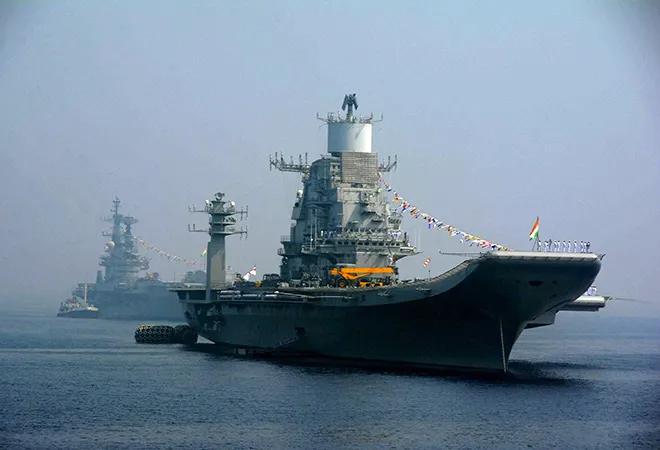The lack of progress at the 12th India-Japan Summit on the possible acquisition of the Japanese-built ShinMaywa US-2i amphibious aircraft may just have saved the Indian Navy in the short term from the acquisition of a grand-sounding niche platform of limited use. For a navy wandering the far seas with warships with mostly empty helicopter decks, the prospect of acquiring any helicopter is of utmost importance versus the acquisition of a superfluous seaplane.
The Japanese-built ShinMaywa US-2i amphibious aircraft is optimised for search and rescue and has a limited surveillance capability. ShinMaywa and the navy will espouse "versatile capabilities" like landing troops on remote islands in the Andaman and Nicobar islands and delivery of spares and personnel to ships at sea. A piecemeal expensive acquisition of capabilities so specific makes one wonder if the navy will ever be regularly tasked with operations that require such capabilities. Case in point, the Japanese Self Defence Forces currently only operate five examples of the platform. The navy would do well to use this $1.3 billion in acquiring aviation assets in areas where it faces more critical shortages given its budgetary constraints.
Last month the navy had issued a request for information (RFI) to global manufacturers for technologies and capabilities for the procurement of 123 naval multi-role helicopters and 111 naval utility helicopters. The procurement would be under the recently approved strategic partnership model of the defence procurement procedure.
The Indian Navy’s current shortage of helicopters is so acute that most warships sail without their approved air component, leaving them virtually blind against underwater threats. Those in the know indicate that last year the navy sent the frigates INS Sahyadri, INS Satpura, fleet tanker INS Shakti and missile corvette Kirch for a two-and-a-half-month operational deployment to the South China Sea and Pacific with just one ageing anti-submarine helicopter between them — leaving the ships blind underwater during their transit through Peoples Liberation Army Navy-dominated waters of East Asia.
While the navy has made significant progress in acquiring government approval for a warship programme, it has failed to acquire approval for adequate multi-role ship-borne helicopters. This significantly reduces the ability of Indian vessels to triangulate and engage underwater targets.
Submarines are one of the fastest growing areas of military modernisation in the Indo-Pacific. By 2020, China is likely to have a fleet of more than 70 submarines. The focus on China’s rapidly growing underwater warfare capability is central to understanding the importance of anti-submarine warfare for the Indian Navy.
The additional capability in the form of anti-submarine warfare helicopters, not "non-weaponised" seaplanes, will be crucial, as warships and even submarines can find it very difficult to reliably find, shadow, and maintain contact with modern rival submarines in large ocean expanses.
According to the RFI, the naval utility helicopter requirement is meant to replace the outdated Chetak currently operated by the navy. These are expected to be capable of search and rescue, utility, limited maritime surveillance and targeting capabilities and are expected to be lightly armed.
The navy’s rotary wing procurement plans also intend to replace and build on its fleet of Sea King and the Kamov 31 helicopters with procurement of 123 naval multi-role helicopters. These are also expected to conduct anti-submarine, anti-surface warfare apart from the usual search and rescue and utility roles of all naval ship borne helicopters. If the roles and capabilities sound similar and overlapping, they are.
The navy also concurrently continues to pursue the purchase of 16 multi-role helicopters in the form of the Sikorsky S-70B. At the risk of sounding monotonous, these too are expected to conduct anti-submarine, anti-surface warfare, search and rescue and utility roles.
Why is the navy procuring different helicopters to fulfil two ends on the same capability spectrum? Improving affordability in areas of acquisition, maintenance and training must receive primacy in the naval planning. The navy would be better off with a single platform to leverage engine and systems commonality, reducing costs in the form of maintenance, acquisition of spares and the training of pilots and maintenance crews. The navy needs to urgently adopt an approach of acquisition where it receives the greatest returns on its investments, closing its capability gaps.
There exists potential for cooperation between India and Japan in the maritime domain, it does not necessarily have to be in the form of the ShinMaywa US-2i seaplane. Japan could help India with its chronic shortage of submarines, cater to its expanding requirement for amphibious warships — known as landing platform docks (LPDs) to expand its operational capabilities.
India needs to be imaginative and focused in acquiring systems which enhance its capabilities while fitting into its long-term procurement plans. Acquiring new aircraft and ships to fulfil each technical or performance need in isolation is not a long-term or affordable solution. Procurements need to cater to inter-operable and integrated war-fighting capabilities, which not only increases war-fighting ability but also improves affordability by reducing acquisition, operating, integration and training costs.
This commentary is originally appeared in Live Mint.
The views expressed above belong to the author(s). ORF research and analyses now available on Telegram! Click here to access our curated content — blogs, longforms and interviews.




 PREV
PREV


